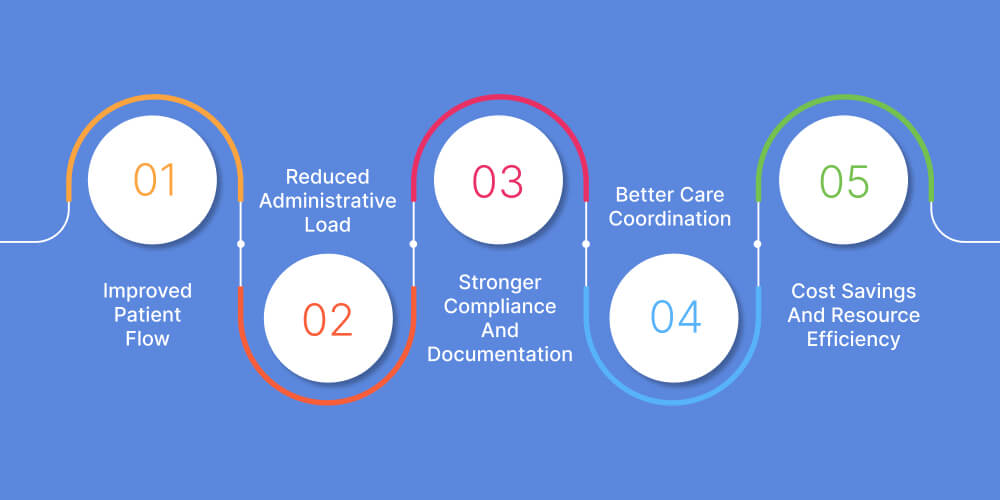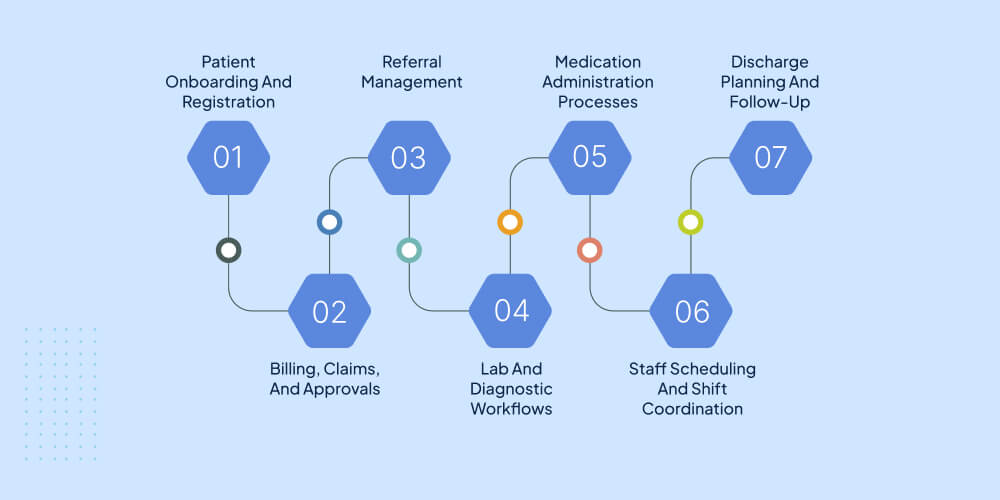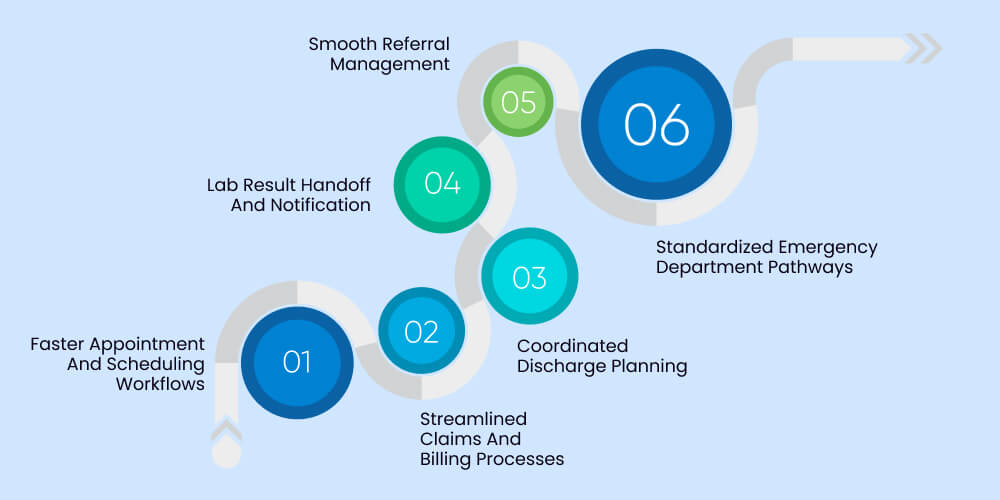What is BPM in Healthcare?
Ditstek Blogs
Today's complex healthcare organizations are under pressure not only to offer the best possible patient care but also to manage their budgets, and comply with regulations. BPM, which stands for Business Process Management, has come up as a strong tool to enable providers in the healthcare industry to do exactly that.
BPM is a perfect way of automating, monitoring, and eventually optimizing processes, including diagnostic workflows, billing, discharge, and follow-up care. The hospitals and clinics can all be made more efficient, within a partial or full BPM application, resulting in the removal of bottlenecks, the minimizing of repetition, the setting of standards based on best practices.
What is the outcome of using BPM in healthcare? Quicker patient checkups, a drop in the number of errors, a decrease in operational expenses, coupled with a rise in patient satisfaction. In a sector where every second and each decision counts, BPM is a necessity for healthcare quality reform.
This blog shares the role and importance of business process management in the healthcare industry, steps to implement and some real-world examples.
What Is BPM In Healthcare Business?
If someone asks, “What exactly is BPM in healthcare?” the simplest answer is this - it’s a structured way for healthcare organisations to define how their daily work should move from one step to the next. Instead of relying on memory, paper forms, or disconnected systems, business process management helps create clear workflows that guide everything from patient intake to billing.
To put it in simple words, bpm in healthcare acts like a map. It shows where a task begins, who handles it next, and how it can be completed without delays. When the map is visible, it gets easier to remove bottlenecks, avoid repeated work, and reduce the mistakes that often slow teams down.
In many Canadian healthcare settings, work is spread across multiple tools and departments. A patient’s chart might be updated in one system, their appointment handled in another, and their billing is done somewhere else. BPM connects these steps, so staff don’t have to chase information or guess what comes next.
Organizations use this approach because BPM answers big operational questions quickly —
- Where are we losing time?
- Why do certain approvals take so long?
- Which tasks depend on manual effort that can be automated?
When these answers show up clearly, the entire care process starts to feel smoother and more predictable.
Want Predictable Healthcare Workflows?
Transform fragmented processes into structured, intelligent flows that support compliance, efficiency, and measurable clinical impact across your facility.
Why Healthcare Organizations in Canada Need BPM
Hospitals, clinics, and community-care centres handle thousands of tasks every single day. But almost all of them depend on a process that needs to move without getting stuck.
Healthcare organizations use business process management as it makes these daily activities predictable. Not perfect - just predictable enough that the team do not experience delays while managing day-to-day tasks.
For example, if a patient referral keeps getting lost between departments, BPM helps track where the delay starts and how to fix it. If discharge planning takes too long, BPM highlights the exact steps slowing it down.
Canadian healthcare providers also face strict compliance rules, more documentation, and rising demand. When processes aren’t clear, small inefficiencies spread fast, causing delays and inefficiencies. A missing approval turns into a long wait. A slow handoff creates extra work. And in many cases, the patient feels the impact first.
BPM gives organizations visibility they often don’t have. It answers direct operational questions:
- Which workflows are creating the longest delays?
- Why are manual steps still required here?
- How can teams reduce back-and-forth communication?
Once leaders see the answers, improving them becomes far easier than expected.
Key Benefits of BPM In Healthcare

When organizations look at BPM, they’re usually trying to answer one practical question:
What improvements will we see if we change the way our processes run?
The benefits aren’t theoretical, and they show up in everyday tasks. Let's explore the key benefits of using BPM In healthcare.
Improved Patient Flow
One of the biggest advantages is faster movement through the system. BPM helps healthcare teams see exactly where patients get stuck during registration, tests, or during discharge planning. Once the bottleneck becomes clear, fixing it becomes far simpler. And with smoother flow, the entire clinical environment feels less rushed.
Reduced Administrative Load
A lot of delays come from paperwork, approvals, and repetitive data entries. Business process management eliminates many of these manual steps by offering a structured workflow to healthcare teams. Tasks move from one person to the next without backtracking. As a result, staff get more time for patients and spend less time hunting for missing details.
Stronger Compliance And Documentation
Canadian healthcare organizations deal with heavy reporting needs. BPM supports consistent documentation and audit-friendly workflows. When tasks follow the same steps every time, the chances of missing things drops dramatically.
Better Care Coordination
Departments often work in silos. A lab team might not see what the nursing team needs, or admin staff may not know when clinical updates are ready. BPM creates a clear path for information to travel across the organization. It reduces the back-and-forth and removes uncertainty about “who should handle this next.”
Cost Savings And Resource Efficiency
Wasted time adds up - so does repeating the same task in different systems. With BPM, organizations spot inefficiencies faster and can shift resources where they’re needed. Even small changes, such as reducing duplicate data entry or streamlining a slow approval process, can lead to noticeable cost savings over a year.
Healthcare teams working on digital solutions, like healthcare app development, often use BPM as the base for designing cleaner and more efficient workflows. It keeps the digital and operational parts of the organization aligned.
Common Healthcare Processes That BPM Transforms

When healthcare organizations start using BPM, the first surprise is usually how many everyday processes can be improved without major system changes. Most workflows look simple on the surface, but once you map them out, you see a series of small delays that slow everything down. BPM helps untangle these steps and rebuild them in a cleaner way.
Patient Onboarding And Registration
This is one of the busiest points in any healthcare setting. BPM helps move patients through check-in faster by guiding staff through accurate, consistent steps. No missing fields, no repeated questions, and fewer interruptions. The experience feels smoother not just for patients but also for teams handling the front desk.
Billing, Claims, And Approvals
Financial workflows often involve several handoffs: admin, insurance, accounting, and sometimes clinical teams. BPM creates a single, traceable path from claim submission to final approval. It reduces the back-and-forth and clears up the confusion that usually causes payment delays.
Referral Management
Referrals can easily get lost if they aren’t structured well. BPM shows who should receive the referral next, whether additional details are needed, and how long each step is taking. When every referral is visible, missed follow-ups drop sharply.
Lab And Diagnostic Workflows
Tests, imaging, and lab results require precise timing. BPM helps teams coordinate scheduling, sample movement, and report delivery. The flow becomes more predictable, which reduces the long wait times between appointments and improves patient satisfaction.
Medication Administration Processes
Medication workflows depend on accuracy and speed. BPM supports clear pathways for orders, verification, and updates to patient records. It helps close gaps that might otherwise lead to delays or duplicated work.
Staff Scheduling And Shift Coordination
Managing staff availability is harder than it looks. BPM streamlines shift approvals, replacements, escalation rules, and workload distribution. It reduces the last-minute scramble that happens when schedules don’t sync across departments.
Discharge Planning And Follow-Up
Discharge is one of the most common areas where delays occur. BPM organizes the steps - paperwork, instructions, prescriptions, coordination with the care team, so the process moves without guesswork. It also supports clean handoffs for follow-up appointments or community care.
Organizations working through digital transformation often evaluate process clarity before moving to custom digital tools. It helps them understand not just workflows but also the cost to build an app in Canada, since the complexity of these processes directly affects their software needs.
Struggling With Operational Inefficiencies?
Pinpoint hidden workflow gaps with precision engineering and rebuild them through rule-based automation aligned to clinical and administrative realities.
Steps To Implement BPM In A Healthcare Organization

When a healthcare organization decides to improve its workflows, the first question that usually comes up is, “Where do we even begin?” BPM isn’t rolled out in one big step. It moves in stages, each one helping teams understand their processes better before making changes.
Assess Current Processes
Everything starts with a simple review. Teams look at how tasks are being handled today patient intake, billing, communication, referrals, scheduling. The goal isn’t to point out mistakes but to see the real picture. Most organizations find steps they didn’t even know existed until they map things out.
Identify Gaps And Delays
Once the workflow becomes visible, the issues start to show themselves. A slow handoff. A missing approval. A paper form that only one person knows how to read. BPM highlights these delays so leaders know exactly what needs fixing instead of guessing.
Map Improved Workflows
After the issues are clear, teams design a smoother version of the same process. This stage often feels eye-opening. It’s where organizations realize how much time gets lost in unnecessary steps. The new flow focuses on clarity - fewer loops, fewer manual tasks, and a cleaner path from start to finish, improving the overall business workflow.
Select BPM Software
No single tool is right for every organization. What will be the right BPM system depends on the organization's needs: integrations, automation rules, analytics, or role-based routing. Generally, healthcare teams will choose a tool that works well with their existing clinical and administrative systems.
Integrate With Existing Tools
BPM is most impactful when it connects with EHRs, scheduling software, lab management tools, and communication tools. Integration eliminates the need to input the same data multiple times and ensures that data passes along the workflow automatically.
Train Teams and Roll Out
Implementing a new process takes time and patience. Staff complete hands-on training, they test workflow, and provide feedback. The goal is not to be perfect; it is to be comfortable. The more seamless the process, the greater the opportunities for sustained results.
Monitor and Improve
BPM is not something an organization can set up and forget about. Workflows change with new regulations, staffing opportunities, or operational needs. By providing real-time data, and relatively simple process change, teams can improve operations without disrupting work.
Real-World Examples of BPM In Healthcare

Real-world use cases show why BPM has become so valuable in Canadian healthcare settings. These aren’t large transformations. They’re small workflow changes that make everyday work noticeably smoother.
Faster Appointment And Scheduling Workflows
Many clinics use BPM to manage patient scheduling without the usual back-and-forth. When a workflow is automated, the system knows which provider is available, which room is open, and whether the required tests are already completed. This reduces booking errors and shortens the wait for patients who need a quick follow-up.
Streamlined Claims And Billing Processes
BPM is often used to eliminate the delays that come from manual approvals. With automated routing, claims move from submission to review without sitting in someone’s inbox for days. Staff can track where each claim is, which improves accuracy and reduces write-offs caused by missed timelines.
Coordinated Discharge Planning
One of the toughest workflows is discharge. Multiple departments need to complete their tasks — pharmacy, nursing, physician notes, instructions, and sometimes home-care coordination. BPM connects these steps into a single flow so everyone sees what’s pending. Patients go home sooner, and staff avoid the last-minute scramble.
Lab Result Handoff And Notification
In busy facilities, lab results can get delayed simply because nobody knew they were ready. BPM automates notifications, routes results to the right clinician, and ensures follow-up actions are clear. It keeps teams from searching through multiple systems or waiting for someone to send an email.
Smooth Referral Management
Referrals are easily lost when handled through phones or scattered documents. With BPM, each referral becomes trackable. Teams can see where it’s stuck, who needs to take action, and whether additional information is required. That visibility alone improves patient continuity and reduces missed appointments.
Standardized Emergency Department Pathways
Some hospitals use BPM to support triage pathways. It doesn’t replace medical judgment but ensures that critical steps: screening tests, documentation, escalation rules happen in the right sequence. It helps teams move faster without missing essential checks.
Organizations working on digital tools often use BPM insights to guide their planning. When workflows become clear, it’s easier to understand what software features they need, which integrations matter, and what level of customization is required. It’s also why many teams revisit their workflow structure before estimating the cost to build an app in Canada, because real processes determine the real scope.
Why Partner With A Professional BPM Development Company
Healthcare workflows aren’t simple. Even a regular day involves dozens of moving parts approvals, handoffs, documentation, follow-ups. When organizations try to streamline these processes without the right expertise, the result often feels more complicated instead of easier. That’s where partnering with a BPM-focused development company makes sense.
A professional team like DITS understands how healthcare operations work behind the scenes. They know that clinical and administrative tasks don’t follow the neat patterns found in other industries. Workloads shift constantly. Urgent tasks appear out of nowhere. Staff changes happen mid-shift. We at DITS build solutions that adjust to these realities instead of fighting them.
Another advantage is customization. Off-the-shelf tools may look attractive at first, but they rarely match the actual workflow of a hospital or clinic. A specialized BPM team studies the organization’s current processes, identifies gaps, and creates a solution that guides work the way the teams already operate. It feels more natural, and adoption becomes far easier.
Technical expertise matters too. Our development team at DITS have a deep expertise in integrating BPM with EHR systems, scheduling tools, diagnostic platforms, and IOT devices. We also offer custom IOT app development services to healthcare businesses. DITS ensures these connections run smoothly, so staff don’t waste time switching between systems.
This is also where DITS becomes a reliable choice. We design BPM-driven healthcare solutions that match real operational needs instead of theoretical models. Our team uses AI across development, quality assurance, and code optimization, which helps organizations get faster updates, cleaner systems, and flexible workflows that scale with demand.
When organizations have the right partner, BPM stops feeling like a technical project and starts becoming a practical way to improve patient flow, reduce stress on staff, and build a more efficient care environment.
Want Seamless System Integration?
Connect EHRs, diagnostics, scheduling, and IoT devices into one continuous BPM-powered ecosystem that accelerates patient flow.
Conclusion
When healthcare organizations step back and look at the way their daily work moves, it becomes clear how much depends on simple processes running the way they should. When workflows are structured, staff know what comes next. Patients move through the system faster. And leaders finally get the visibility needed to improve operations without guessing.
As digital tools continue to grow and more facilities move toward integrated systems, BPM becomes the backbone that keeps everything connected and consistent.
Healthcare is changing quickly, but the organizations that thrive are the ones that focus on their processes first. With clear workflows and the right technology partners, improvements don’t just happen they stay.
FAQs
What Is BPM Used For In Healthcare?
BPM is used to organize and streamline the internal workflows of a healthcare organization. It helps teams manage tasks like registration, billing, referrals, and documentation in a consistent, predictable way. When these processes run smoothly, patient flow improves and staff spend less time on manual steps.
Can BPM Integrate With Existing Healthcare Software?
Yes. Modern BPM tools are designed to connect with EHR systems, scheduling software, diagnostic tools, and billing platforms. This integration removes duplicate data entry and keeps information flowing across departments without manual effort.
How Long Does It Take To Implement BPM?
The timeline depends on the size of the organization and the number of workflows being redesigned. Some teams improve a single process in a few weeks, while full BPM adoption can take a few months. Most organizations start small and expand gradually.
What Problems Does BPM Solve For Healthcare Teams?
BPM helps address issues like long wait times, manual documentation, lost referrals, slow handoffs, and inconsistent processes. It surfaces bottlenecks, highlights delays, and creates a cleaner sequence of steps for staff to follow.
Why Should Healthcare Organizations Work With DITS?
A professional BPM team like DITS understands healthcare operations, integrations, compliance needs, and the practical challenges staff face every day. They design workflows that fit the organization rather than forcing everyone to adjust to generic models. This leads to smoother adoption and long-term improvement.

Nidhi Thakur
With more than 19 years of experience - I represent a team of professionals that specializes in the healthcare and business and workflow automation domains. The team consists of experienced full-stack developers supported by senior system analysts who have developed multiple bespoke applications for Healthcare, Business Automation, Retail, IOT, Ed-tech domains for startups and Enterprise Level clients.
Recent Posts
Get in touch










 Calgary | Edmonton | Vancouver | Toronto
Calgary | Edmonton | Vancouver | Toronto Marriott Downtown Hotel | Calgary
Marriott Downtown Hotel | Calgary